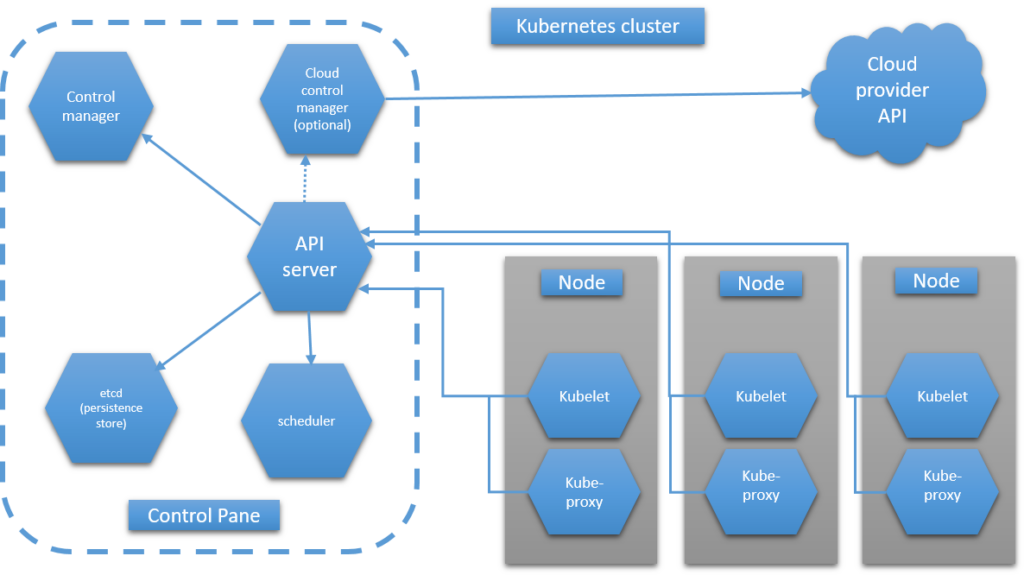Understanding Kubernetes architecture is essential for leveraging its full potential in container orchestration. Kubernetes, an open-source platform, automates the deployment, scaling, and management of containerized applications. Its architecture is designed for resilience, scalability, and efficiency, making it a cornerstone of modern cloud-native application development.

What is Kubernetes Architecture?
Kubernetes architecture is a distributed system that manages containerized applications at scale. It consists of control planes and worker nodes, each with specific roles that work together to ensure application reliability and availability.
Why Kubernetes Architecture Matters:
- Simplifies container management at scale.
- Ensures high availability and fault tolerance.
- Automates resource optimization for applications.
Key Components of Kubernetes Architecture
Kubernetes architecture is divided into two main components: the Control Plane and Worker Nodes.
1. Control Plane
The control plane manages the Kubernetes cluster and serves as its brain, orchestrating the entire system.
Core Components of the Control Plane:
- API Server:
Acts as the front-end, exposing the Kubernetes API for interaction.- Role: Handles all REST requests and updates the cluster state.
- Etcd:
A distributed key-value store that stores the cluster’s configuration and state.- Role: Acts as the source of truth for the cluster.
- Controller Manager:
Runs control loops to manage the desired state of the cluster.- Role: Ensures replicas, nodes, and other resources meet desired configurations.
- Scheduler:
Allocates workloads (pods) to available nodes.- Role: Optimizes resource allocation and balances workloads.
2. Worker Nodes
Worker nodes are where the actual application workloads run. Each node includes components that communicate with the control plane.
Core Components of Worker Nodes:
- Kubelet:
An agent that runs on every node to manage container operations.- Role: Ensures containers are running as specified.
- Kube-Proxy:
Handles network communication within and outside the cluster.- Role: Manages routing and load balancing for services.
- Container Runtime:
Software like Docker or containerd that runs containers.- Role: Executes and manages containers on the node.
How Kubernetes Architecture Works
Kubernetes architecture works through a collaborative effort between its control plane and worker nodes:
- User Interaction:
Developers interact with Kubernetes using the API Server or tools likekubectl. - Control Plane Execution:
The control plane processes requests, updates the cluster state inetcd, and assigns workloads to nodes. - Workload Deployment:
Worker nodes execute workloads based on instructions from the control plane.
Features of Kubernetes Architecture
1. Scalability:
Automatically adjusts resources based on application demand.
2. High Availability:
Built-in redundancy ensures fault tolerance and reliability.
3. Self-Healing:
Automatically replaces failed pods or nodes to maintain system health.
Advantages of Kubernetes Architecture
- Efficient Resource Utilization: Optimizes CPU and memory usage across clusters.
- Simplified Orchestration: Automates container deployment and scaling.
- Cross-Platform Portability: Supports multiple cloud providers and on-premises environments.
- Modularity: Enables integration with custom tools and third-party solutions.
Challenges of Kubernetes Architecture
While Kubernetes architecture offers numerous benefits, it has some challenges:
- Complexity: The architecture requires expertise to set up and manage.
- Resource Overhead: Kubernetes can be resource-intensive for small-scale deployments.
- Learning Curve: Understanding its components and workflows can be challenging for beginners.
Tools Supporting Kubernetes Architecture
Several tools enhance Kubernetes architecture by providing additional functionality:
- Helm: Simplifies application deployment through package management.
- Prometheus: Provides monitoring and alerting capabilities.
- Istio: Enhances service mesh functionality for networking and security.
FAQ: Frequently Asked Questions
1. What is Kubernetes architecture?
Kubernetes architecture is a distributed system for managing containerized applications using control planes and worker nodes.
2. How does the control plane work in Kubernetes?
The control plane orchestrates the cluster, managing workloads, resources, and cluster state.
3. What is the role of etcd in Kubernetes architecture?
etcd is a distributed key-value store that acts as the source of truth for the cluster state.
4. Can Kubernetes run without Docker?
Yes, Kubernetes supports other container runtimes like containerd and CRI-O.
5. Is Kubernetes architecture suitable for small businesses?
While resource-intensive, Kubernetes can be adapted for small-scale deployments with managed services like GKE or EKS.
Conclusion
Understanding Kubernetes architecture is fundamental for managing containerized applications efficiently. Its modular and resilient design ensures scalability, high availability, and optimal resource utilization. By mastering its components, you can build robust systems that meet modern application demands.